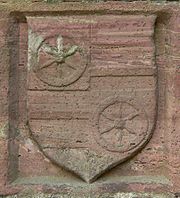
Diether von Isenburg
Encyclopedia


German language
German is a West Germanic language, related to and classified alongside English and Dutch. With an estimated 90 – 98 million native speakers, German is one of the world's major languages and is the most widely-spoken first language in the European Union....
: Diether von Isenburg) (c. 1412 – 7 May 1482) was Elector and Archbishop of Mainz from 1459 until 1461, and again from 1475 until 1482.
Biography
Theodoric was a son of Count Theodoric I of Isenburg-BüdingenIsenburg-Büdingen
Isenburg-Büdingen was a County of southern Hesse, Germany, located in Büdingen. There were two different Counties of the same name. The first was a partition of Isenburg-Cleberg, and was partitioned into Isenburg-Büdingen-Birstein and Isenburg-Ronneburg in 1511. The second was a partition of...
.
Early in childhood he was sent into a religious life. He was educated in Cologne
Cologne
Cologne is Germany's fourth-largest city , and is the largest city both in the Germany Federal State of North Rhine-Westphalia and within the Rhine-Ruhr Metropolitan Area, one of the major European metropolitan areas with more than ten million inhabitants.Cologne is located on both sides of the...
and later Erfurt
Erfurt
Erfurt is the capital city of Thuringia and the main city nearest to the geographical centre of Germany, located 100 km SW of Leipzig, 150 km N of Nuremberg and 180 km SE of Hannover. Erfurt Airport can be reached by plane via Munich. It lies in the southern part of the Thuringian...
. In 1427 he became a member of Mainz Cathedral
Mainz Cathedral
Mainz Cathedral or St. Martin's Cathedral is located near the historical center and pedestrianized market square of the city of Mainz, Germany...
, in 1434 a rector in Erfurt
Erfurt
Erfurt is the capital city of Thuringia and the main city nearest to the geographical centre of Germany, located 100 km SW of Leipzig, 150 km N of Nuremberg and 180 km SE of Hannover. Erfurt Airport can be reached by plane via Munich. It lies in the southern part of the Thuringian...
, and in 1453 a cathedral vicar. In 1456 the cathedral chapter of Trier
Trier
Trier, historically called in English Treves is a city in Germany on the banks of the Moselle. It is the oldest city in Germany, founded in or before 16 BC....
elected John II of Baden against Theodoric. On 18 June 1459 Theodoric was elected the Archbishop of Mainz with a clear majority over Adolph of Nassau-Wiesbaden-Idstein, however the Pope never confirmed Theodoric. In 1461 he went to Nuremberg
Nuremberg
Nuremberg[p] is a city in the German state of Bavaria, in the administrative region of Middle Franconia. Situated on the Pegnitz river and the Rhine–Main–Danube Canal, it is located about north of Munich and is Franconia's largest city. The population is 505,664...
for Imperial and Papal reform, and its recommendations earned Theodoric the wrath of both the Emperor Frederick III and Pope Pius II
Pope Pius II
Pope Pius II, born Enea Silvio Piccolomini was Pope from August 19, 1458 until his death in 1464. Pius II was born at Corsignano in the Sienese territory of a noble but decayed family...
.
Theodoric refused to cease reforms in the church, and thus Pius II declared Adolph of Nassau the Archbishop of Mainz, beginning the Mainzer Feud. The archdiocese was wracked by violent warfare. On the night of 28 October 1462 Adolph captured the city of Mainz, killed 400 citizens and had another 400 including Johannes Gutenberg exiled, and revoked its town charter and status as an Imperial City
Imperial City
-Places:* Imperial City, Beijing, the central section of Beijing* Imperial City , a walled fortress and palace in the former capital of Vietnam.* Free imperial city, city formally responsible only to the emperor in the Holy Roman Empire,....
. However Theodoric did not leave the city until 1463. When Adolph died in 1475 he recommended Theodoric be his successor, and on 9 November that year he was again elected. The reformist Pope Sixtus IV
Pope Sixtus IV
Pope Sixtus IV , born Francesco della Rovere, was Pope from 1471 to 1484. His accomplishments as Pope included the establishment of the Sistine Chapel; the group of artists that he brought together introduced the Early Renaissance into Rome with the first masterpiece of the city's new artistic age,...
confirmed him. In 1477 Theodoric donated the University of Mainz to the city.
Theodoric died in Aschaffenburg
Aschaffenburg
Aschaffenburg is a city in northwest Bavaria, Germany. The town of Aschaffenburg is not considered part of the district of Aschaffenburg, but is the administrative seat.Aschaffenburg is known as the Tor zum Spessart or "gate to the Spessart"...
in 1482 and was buried in Mainz Cathedral.

